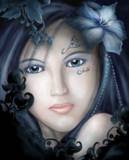Chairil Anwar: Poet of a Generation
by Tinuk Yampolsky
by Tinuk Yampolsky
Chairil Anwar: every Indonesian schoolchild knows his name. For this poet was one of the famed figures of the “1945 Generation,” that group of luminaries who brought heat and light to Indonesian literature in the formative years of the new nation.
Through his poetry, Chairil Anwar succeeded in infusing Indonesian verse with a new spirit and bringing a new enthusiasm to Indonesia’s cultural arena. He also provided friends and acquaintances with never-ending tales to tell of his personal eccentricities, including his hobby of stealing books from the shops, his tendency to plagiarize from foreign poets, his many lovers, his numerous ailments, and his bohemian lifestyle.
Born on July 22, 1922 in Medan, North Sumara, Chairil attended the Hollands Inlandsche School (HIS), a Dutch elementary school for “natives.” He then continued his education at the Meer Uitgebreid Lager Onderwijs, a Dutch junior high school, but he dropped out before graduating. At the age of nineteen, after the divorce of his parents, Chairil moved with his mother to Jakarta where he came in contact with the literary world. Despite his unfinished education, Chairil had an active command of English, Dutch and German, and he filled his hours by reading an international selection of authors, including Rainer M. Rilke, W.H. Auden, Archibald MacLeish, H. Marsman, J. Slaurhoff and Edgar du Perron. These writers became his references, directly influencing his own poetry and later helping him shift the gaze of Indonesian literature to fall upon Europe. This westward turn was one of the major differences between Chairil’s “1945 Generation” peers and the previous cohort of Indonesian writers, the “New Authors Generation” of the 1930s, who were more oriented toward traditional verse forms. Chairil’s poetry was not only topically fresh, it struggled with individual and existential issues, in contrast to the writers of the “New Authors Generation” who were more concerned with giving voice to nationalist enthusiasm.
Through his poetry, Chairil Anwar succeeded in infusing Indonesian verse with a new spirit and bringing a new enthusiasm to Indonesia’s cultural arena. He also provided friends and acquaintances with never-ending tales to tell of his personal eccentricities, including his hobby of stealing books from the shops, his tendency to plagiarize from foreign poets, his many lovers, his numerous ailments, and his bohemian lifestyle.
Born on July 22, 1922 in Medan, North Sumara, Chairil attended the Hollands Inlandsche School (HIS), a Dutch elementary school for “natives.” He then continued his education at the Meer Uitgebreid Lager Onderwijs, a Dutch junior high school, but he dropped out before graduating. At the age of nineteen, after the divorce of his parents, Chairil moved with his mother to Jakarta where he came in contact with the literary world. Despite his unfinished education, Chairil had an active command of English, Dutch and German, and he filled his hours by reading an international selection of authors, including Rainer M. Rilke, W.H. Auden, Archibald MacLeish, H. Marsman, J. Slaurhoff and Edgar du Perron. These writers became his references, directly influencing his own poetry and later helping him shift the gaze of Indonesian literature to fall upon Europe. This westward turn was one of the major differences between Chairil’s “1945 Generation” peers and the previous cohort of Indonesian writers, the “New Authors Generation” of the 1930s, who were more oriented toward traditional verse forms. Chairil’s poetry was not only topically fresh, it struggled with individual and existential issues, in contrast to the writers of the “New Authors Generation” who were more concerned with giving voice to nationalist enthusiasm.
Chairil began to gain recognition as a poet with the publication of “Nisan” (“Gravestone”) in 1942. At that time, he was only twenty years old. He had apparently been shocked by the death of his grandmother, which awakened him to the fact that death could at any moment tear one away from life. Most of the poems he wrote after this point referred, at least implicitly, to this awareness of death. All of his poems—the originals, the adaptations and those suspected of being plagiarisms—have been collected in three books: Deru Campur Debu (“Roar Mixed with Dust,” 1949); Kerikil Tajam Yang Terampas dan Yang Putus (“Sharp Pebbles The Seized and the Severed,” 1949); and Tiga Menguak Takdir (“Three Tear Open Fate,” 1950, a collection of poems with Asrul Sani and Rivai Apin).





0 comments:
Post a Comment